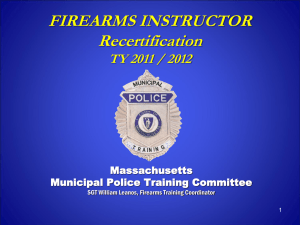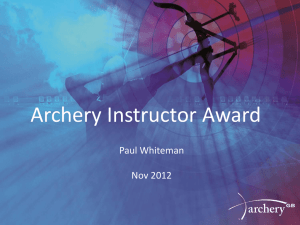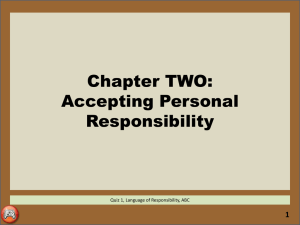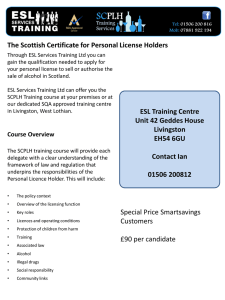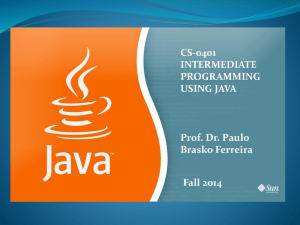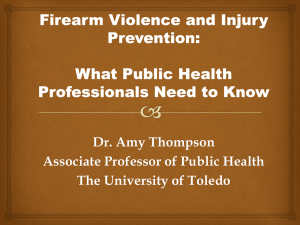mptc firearms inst recert `09 - `10
advertisement
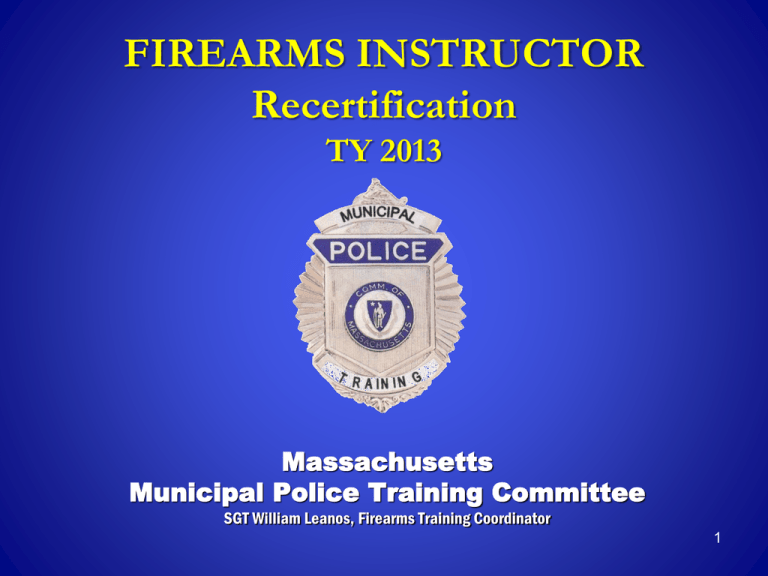
FIREARMS INSTRUCTOR Recertification TY 2013 Massachusetts Municipal Police Training Committee SGT William Leanos, Firearms Training Coordinator 1 Author: Sgt. William Leanos & MPTC Firearms Training Advisory Committee Based on the 2013 Distance Learning program developed by Steve Taranto & Todd Bailey Slide show presentation by Todd Bailey 2 HOT TOPICS FOR TY 2013 Distance Learning Program Area Representatives Electronic Certificates Website News & Information page MPTC Instructor Levels I & II New Shotgun Program & Qualification State Standard for Qualification & Training 3 HOT TOPICS FOR TY 2013 Updated Service Pistol Qualification - 7 Yard stage - Round Accountability on the range and on the street - Required hits at each stage Remedial Training 4 OBJECTIVES FOR TY 2013 Identify relationship Area Representatives have with the individual instructor Know where the use of a firearm falls on to the MPTC Use of Force model Know how to access the MPTC Firearms Training website and your electronic certificates State the four instructor levels and the differences between Level I and II 5 OBJECTIVES FOR TY 2013 Identify the difference between training and qualification State your department’s firearms training responsibilities with regard to the MPTC Standard for Requalification and Training of Municipal Police Officers Demonstrate your proficiency and ability to meet the minimum standard for instructor requalification with applicable weapon systems Demonstrate an understanding of the MPTC scoring system and 100% round accountability 6 MPTC Use of Force Model 7 Legal Issues – Use of Force Tenn v. Garner (1985) Deadly force may not be used against a non-dangerous fleeing suspect UNLESS it is necessary to prevent escape AND the suspect poses a significant threat of death or serious bodily injury to the officer or others. Graham v. Conner (1989) Claims of excessive force are analyzed under the 4th Amendment’s “objective reasonableness” standard. 8 Legal Issues – Use of Force Julian v. Randazzo (1989) Established that Section 120.7 of the Model Code of Prearrainment Procedure is the standard by which a police officer can use deadly force in the Commonwealth. "A law enforcement officer authorized to make an arrest . . . may use such force as is reasonably necessary to effect the arrest . . . . The officer may use deadly force for these purposes only if (a) the arrest is for a felony; and (continued on next page) 9 Legal Issues – Use of Force Julian v. Randazzo (1989) (cont.) (b) the officer reasonably believes that the force employed creates no substantial risk to innocent persons; and (c) the officer reasonably believes that: (i) the crime for which the arrest is made involved conduct including the use or threatened use of deadly force; or (ii) there is a substantial risk that the person to be arrested will cause death or serious bodily harm if his apprehension is delayed." 10 Legal Issues – Failure to Train Canton v. Harris (1989) - A municipality’s inadequate training may give rise to a 42 USC 1983 liability when it is deliberately indifferent to the rights of the city’s inhabitants and actually causes the plaintiff’s injury. Popow v. Margate (1979) - Firearms training for police officers should include training related to the conditions the officer is likely to encounter such as moving targets, reduced light and residential areas. 11 Legal Issues – Failure to Train Young v. City of Providence (2005) - This recent case emphasized the importance of documenting training. There was testimony that conflicted on whether certain training actually took place. The court echoed earlier opinions that training must be fully documented for it to have taken place in the eyes of the court. - This is the only protection the instructor has after the fact that they delivered the stated training. 12 DISTANCE LEARNING Classroom session being replaced by the Distance Learning (DL) module Found on MPTC website DL training must be completed PRIOR to attending the practical range session. You must be on the MPTC Database to log on. Instructor Information Update form will be part of this process Be sure to provide an Email address 13 Communication Firearms Training News & Information - www.firearmsinstructor.org Your online source for up to date news, information and course materials - Certificates - Lesson Plans - Forms - Courses of Fire - Manuals - Training Schedule 14 ONLINE SERVICES Certificates are now generated electronically in PDF format Firearms training certificates issued to you since 2007 can be accessed on line. - Go to www.firearmsinstructor.org - Select the CERTIFICATE tab. - Login is the email address you provided to the Firearms Coordinator. If you have a problem – contact your Area Representative FIRST Material will be added and updated as necessary 15 Support Staff Assistant Coordinators Cliff Alves (978) 804-9057 cliffalves@verizon.net Ron Raneri (781) 314-3527 rraneri@police.waltham.ma.us Steve Taranto (781) 724-6569 staranto@police.waltham.ma.us The Assistant Coordinators speak with the authority of the Statewide Coordinator on issues related to firearms training. 16 Support Staff Area Representatives Area 1 – Essex Co., Probation, MBTA, MLEFIAA and IALEFI Cliff Alves (978) 804-9057 cliffalves@verizon.net Area 2 – Middlesex Co, Environmental Police, Federal Agencies Ron Raneri (781) 314-3527 rraneri@police.waltham.ma.us Steve Taranto (781) 724-6569 staranto@police.waltham.ma.us Area 3 – Norfolk and Suffolk Counties, AMTRAK, College PDs, Massport Ron Raneri (781) 314-3527 rraneri@police.waltham.ma.us Area 4 – Berkshire, Franklin, Hampshire, Hampden and Worcester Counties, Mass. State Police Bert DuVernay (508) 867-2059 chief@newbraintree.org Area 5 – Bristol, Barnstable, Dukes, Nantucket and Plymouth Counties, Sheriff’s Offices and DOC Steve Assad (774) 328-2832 smkjoe5931@comcast.net 17 Firearms Training Organization & Information Flow Chart 18 MPTC Instructor Levels All MPTC disciplines have multi-tier instructor system Level I – Basic instructor Level II – Advanced instructor Level III – Lead Instructors for MPTC programs Level IV – Master Instructor Trainer 19 INSTRUCTOR LEVELS Level I (Basic Firearms Instructor) - Entry level for all firearms instructors - Teaches at agency level only - 1 year of FT or PT on the job - Successful completion of 10 Day Basic Firearms Instructor school or approved equivalent (NOT authorized to teach the 20 hour Reserve Intermittent Firearms course) 20 INSTRUCTOR LEVELS Level II (Advanced Firearms Instructor) All Basic / Level I privileges plus - Authorized to teach the 20 hour Reserve Intermittent Officer Firearms Course - May assist with Recruit Academy level program if under MPTC contract - Experience requirement - 4 yrs as basic instructor - Actively teaching - Documentation required 21 INSTRUCTOR LEVELS Level III (MPTC Lead Instructor) All Basic & Level II privileges plus - Authorized to function as Lead Instructor at MPTC Firearms Training programs. - 2 yrs as Level II instructor - 24 hr. MPTC Instructor Development - MPTC Use of Force Instructor - Actively teaching - 24 hrs actively assisting @ MPTC firearms classes under a Level III 22 INSTRUCTOR LEVELS Level IV (MPTC Master Instructor) All Level III privileges plus authorized to teach all MPTC firearms programs. - 4 yrs as Level III instructor - Instructor Development Course - Submit resume and supporting docs to MPTC Firearms Coordinator for review by Steering Committee and approval by Executive Director - Approved only as needed 23 Firearms Instructor Certification Update Certification is now valid for three (3) years 94% is minimum passing score - MPTC / MSA Certification - MSA Certification Optional MSA has adopted MPTC Patrol Rifle & Shotgun qualification courses 100% Round Accountability - All your rounds must land on the “body” 24 INSTRUCTOR RECERTIFICATION REQUIREMENT 100% round accountability Each scored hit = 2 points Hits in the grey silhouette area do not score points however they are considered a “hit”. Hits outside the silhouette area or off the paper are considered a miss. No score for that stage and shooter must re-shoot the stage. Hits within the “milk bottle” score points. This includes the pelvic scoring area. 25 INSTRUCTOR REQUIREMENT 100% Round Accountability Goals: - Improve marksmanship - Enhance officer safety - Enhance safety of the general public - Encourage practice Stresses the importance of making each shot count - 1 accurate shot beats 3 misses all day Instructors will lead from the front by setting the example of marksmanship Rounds not fired due to misfire or malfunction are “accounted for” via an alibi fire or by virtue of not being fired. 26 INSTRUCTOR CERTIFICATION REQUIREMENTS No more than 3 attempts to attain a passing score on qualification. If not; - Repeat Basic Firearms Course Your instructor certification may not be expired for more than 4 years*. If so; - Repeat Basic Firearms Course * w/o approval from Statewide Coordinator (Effective: 1/1/10) 27 NON-INSTRUCTOR QUALIFICATION All Other Personnel MPTC QUALIFICATION COURSE Minimum of 80% for passing score - 40 out of 50 shots in scoring area - 2 pts. per round in scoring area All rounds accounted for on the paper Achieve minimum # of rounds in scoring for that stage (distance). 28 Non-Instructor Requirements Hits within the “milk bottle” score points. This includes the pelvic scoring area. Hits to grey silhouette and outside border on the paper do not score points however they are considered a “hit”. Hits off paper are considered a miss. Shooter must reshoot any stages where a miss occurs. 29 Non-Instructor Round Accountability Department qualifications All rounds must “hit the paper” - Rounds observed to miss the paper are “unaccounted for” - Instructor should use discretion and common sense when scoring targets. Reasoning - Police officers are responsible for every round they fire - Missed rounds can kill or injure innocent bystanders 30 State Standard Commonwealth of Massachusetts now has a written “standard” for firearms qualification & training MPTC Pistol Qualification course is the standard qualification course of fire Applies to all agencies that fall under the MPTC umbrella 31 State Standard Approved in March 2010 Establishes minimum re-qualification and continual training standards At this time, applies ONLY to handgun Required of ALL sworn municipal full and part time police officers in the Commonwealth Acknowledges differences between Qualification & Training 32 Qualification Intended to document - Existing marksmanship proficiency - Ability to handle a firearm safely Annual Qualification - 50 round MPTC qualification course - Minimum passing score of 80% - 94% for instructors - Duty handgun (pistol / revolver) - MPTC approved targets 33 Training Training is intended to improve the officer’s - Marksmanship proficiency - Firearms handling skills under stress in a variety of potential shooting situations as well as to enhance officer safety and the safety of the public. 34 Training Two Annually (within 12 month period) 3 mandatory components - Policy Review to include use of firearms and deadly force, firearms safety and safe storage of firearms - 50 round live fire range training session - Multiple exercises - 2nd practical training session - Separate date - Live fire NOT required at the 2nd session 35 Annual Training Standard Instruction and review of - Deadly force legal issues (case law) - Department policy on use of deadly force - Safe handling of firearms - Safe storage of firearms (c140s131L) This may be done at the time of qualification, range training or on a separate date 36 Annual Training Standard Live fire session will include at least 50 rounds - Broken up into multiple training exercises - Shall be in addition to the 50 rounds fired in the Qualification Course. - May be conducted on the same day as the 50 round Qualification Course - May use any target - Reactive targets encouraged 37 Annual Training Standard Training shall be realistic in nature or scenario based and include - Judgmental shooting - Reduced light shooting - Multiple target drills or scenarios - Moving targets - Shooting while moving - Use of cover - Shooting from a variety of positions - Sighted & Point shooting techniques 38 Annual Training Standard The second training session shall be held on a separate date from the live fire training. No time requirements - i.e. this could be Roll Call training The important thing is to have quality training and properly document the training with lesson plans and training reports. 39 Annual Training Standards Skill building drills may include - Simulators (Range 3000, FATS, etc.) - Simulations (Simunitions®, Airsoft, Plastic rounds or Red/Blue Guns) Departments are encouraged to use MPTC instructors in their programs 40 Evaluation Performance beyond the actual marksmanship score Can be cause for failure of the course of fire Includes - Ability to handle the firearm safely - Cardinal Rules - Move with the firearm safely - Tactics 41 FIREARMS SAFETY RULES REVIEW All weapons are always treated as if they were loaded. Never point a weapon at anything you are not willing to destroy. Keep your finger off the trigger until you are on target and have made the decision to fire. Know your target and what is beyond it. 42 FIREARMS SAFETY RULES Know your target and what is beyond it. Especially in crowds and urban areas, etc. Expect tunnel vision - Look beyond the threat for bystanders - NYPD Empire State Bldg incident Change your angle to the threat if possible for a clear shot Maybe it is not SAFE to take the shot! 43 RANGE RULES Download and print RANGE SAFETY RULES Read the form Sign the form Bring the form with you to the range 44 RANGE New format for 2013 - 2 sessions per day - Morning runs 0700 – 1130 - Afternoon runs 1030 – 1500 - Be sure to specify which session you want Using ALFA Range at Fort Devens - Obey all speed and seat belt laws on base Other locations at North Dartmouth, Barre (MLEFIAA) and Western Mass. 46 Pistol Qualification Revision 7 yard line completely changed Start at 15 yard line - Shooting on the move to 7 yd line (2 rounds) - Shooting from cover* (4 rounds) - 1 handed shooting from cover* - 2 rounds dominant hand only - 2 rounds support hand only *Cover used if available 47 Pistol Qualification Revision Specific requirements on the minimum number of hits required at each distance Distance Min # of hits 15 yards 4 10 yards 8 7 yards 8 5 yards 10 3 yards 10 If the shooter doesn’t meet these minimums, they must reshoot the stage. 3 attempts max. This scoring is independent of the 94% and 80% requirements 48 LEOSA LEOSA Improvements Act passed in 2010 Changes include: - Specifically allows any ammo not prohibited by federal law or subject to Nat’l. Firearms Act - Includes AMTRAK, Federal Reserve and Executive Branch police officers - Redefines retired officers as ones “separated from service in good standing” - Establishes 3 ways for retired officers to qualify (continued) 49 LEOSA (cont.) - Meets qualification standards of their former agency or - Meets qualification standards of state in which they reside or if the state has no qualification standard an agency within the state in which the individual resides or - The standards used by a certified firearms instructor qualified to conduct firearms qualification for active officers in that state. 50 LEOSA (cont.) Creates possible conflicts with state laws - Massachusetts CMR defining retirees, identification cards and qualification - New Jersey law prohibiting hollow point ammo by anyone other than LE on duty Note – LEOSA does not (yet) address the issue of high capacity magazines carried by off duty/retired officers in states prohibiting them. 51 Shotgun Qualification The 25 round Shotgun qualification course is the standard effective Jan. 1, 2013 New program is more practical - Includes downloading / unloading as a testable component - Emphasizes tactical reloading - Incorporates movement, use of cover, multiple rounds and shooting on the move - Commonality in training with Patrol Rifle program 52 New Shotgun Program Core fundamentals: Operation - including accessing from cruiser Marksmanship Loading, downloading & unloading Tactical Reloading ( aka topping off) - “Put back what you shoot” Movement 53 Remedial Training Agency policy on what action will be taken should an officer fail to qualify with any dept. weapon - Criteria for - Immediate remedial training (critical issues) - What warrants taking the officer’s weapon? - Remedial at a later date - Not a safety or serious proficiency issue - # of attempts to qualify allowed - Steps if officer fails to meet agency standards Every reasonable attempt must be made to provide retraining and opportunities to qualify 54 Remedial Training Consistent and/or flagrant violations of standard safety rules in addition to dangerously poor marksmanship must be addressed immediately in the interest of officer and public safety. Marksmanship is a perishable skill - Skill level will deteriorate without sufficient ongoing training - Departments can not reasonably expect an officer to remain proficient without quality ongoing training 55 Remedial Training During the practical portion of the recertification you will see several drills and exercises which are useful to diagnose problem shooters - Wall Drill - 1 Hole Drill - Ball & Dummy Drill - Exemplar Drill - 56 Remember – You do not get sued for ‘failure to qualify’… You are sued for FAILURE TO TRAIN 57

